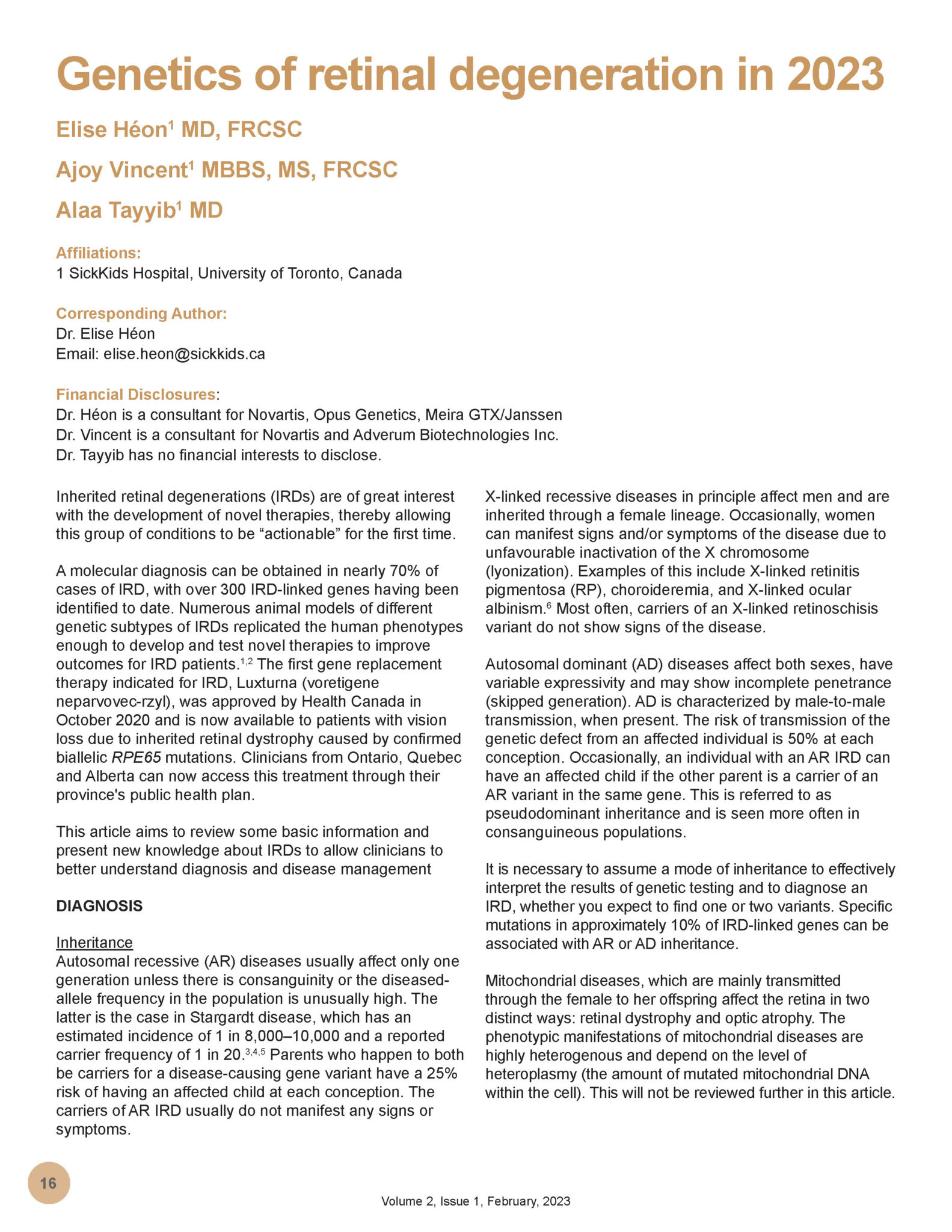Genetics of retinal degeneration in 2023
DOI:
https://doi.org/10.58931/cect.2023.2122Abstract
Inherited retinal degenerations (IRDs) are of great interest with the development of novel therapies, thereby allowing this group of conditions to be “actionable” for the first time.
A molecular diagnosis can be obtained in nearly 70% of cases of IRD, with over 300 IRD-linked genes having been identified to date. Numerous animal models of different genetic subtypes of IRDs replicated the human phenotypes enough to develop and test novel therapies to improve outcomes for IRD patients. The first gene replacement therapy indicated for IRD, Luxturna (voretigene neparvovec-rzyl), was approved by Health Canada in October 2020 and is now available to patients with vision loss due to inherited retinal dystrophy caused by confirmed biallelic RPE65 mutations. Clinicians from Ontario, Quebec and Alberta can now access this treatment through their province’s public health plan.
This article aims to review some basic information and present new knowledge about IRDs to allow clinicians to better understand diagnosis and disease management.
References
Switonski M. Impact of gene therapy for canine monogenic diseases on the progress of preclinical studies. J Appl Genet. 2020 May;61(2):179-186. doi:10.1007/s13353-020-00554-8 DOI: https://doi.org/10.1007/s13353-020-00554-8
Guziewicz KE, McTish E, Dufour VL, et al. Underdeveloped RPE Apical Domain Underlies Lesion Formation in Canine Bestrophinopathies. Adv Exp Med Biol. 2018;1074:309-315. doi:10.1007/978-3-319-75402-4_38 DOI: https://doi.org/10.1007/978-3-319-75402-4_38
Newsome DA. Retinal dystrophies and degenerations., . Lippincott Williams & Wilkins; 1988. DOI: https://doi.org/10.1097/00003226-198903000-00015
Yatsenko AN SN, Lewis RA, Lupski JR. Late-onset Stargardt disease is associated with missense mutations that map outside known functional regions of ABCR (ABCA4). Hum Genet. 2001;108(4):346-355. doi:10.1007/s004390100493 DOI: https://doi.org/10.1007/s004390100493
Al-Khuzaei S, Broadgate S, Foster CR, et al. An Overview of the Genetics of ABCA4 Retinopathies, an Evolving Story. Genes (Basel). 2021 Aug 13;12(8). doi:10.3390/genes12081241 DOI: https://doi.org/10.3390/genes12081241
Wuthisiri W, Lingao MD, Capasso JE, Levin AV. Lyonization in ophthalmology. Curr Opin Ophthalmol. 2013 Sep;24(5):389-97. doi:10.1097/ICU.0b013e3283641f91 DOI: https://doi.org/10.1097/ICU.0b013e3283641f91
Strauss RW KX, Ho A, et al. Progression of Stargardt Disease as Determined by Fundus Autofluorescence Over a 12-Month Period: ProgStar Report No. 11. JAMA Ophthalmol. 2019;137(10):1134-1145. doi:10.1001/jamaophthalmol.2019.2885 DOI: https://doi.org/10.1001/jamaophthalmol.2019.2885
Mao J FD, Chen Y, et al. Prediction of Visual Acuity After Cataract Surgery Using Optical Coherence Tomography Findings in Eyes With Retinitis Pigmentosa. Ophthalmic Surg Lasers Imaging Retina. 2018;49(8):587-594. doi:10.3928/23258160-20180803-06
Olchawa M, Krzysztynska-Kuleta O, Duda M, et al. In vitro phototoxicity of rhodopsin photobleaching products in the retinal pigment epithelium (RPE). Free Radic Res. 2019 Apr;53(4):456-471. doi:10.1080/10715762.2019.1603377 DOI: https://doi.org/10.1080/10715762.2019.1603377
Cremers FPM, Lee W, Collin RWJ, Allikmets R. Clinical spectrum, genetic complexity and therapeutic approaches for retinal disease caused by ABCA4 mutations. Prog Retin Eye Res. 2020 Nov;79:100861. doi:10.1016/j.preteyeres.2020.100861 DOI: https://doi.org/10.1016/j.preteyeres.2020.100861
MacDonald IM, Lee T, Lawrence J. Bestrophinopathies. In: Adam MP, Everman DB, Mirzaa GM, et al, eds. GeneReviews. 1993.
Pfister TA, Zein WM, Cukras CA, et al. Phenotypic and Genetic Spectrum of Autosomal Recessive Bestrophinopathy and Best Vitelliform Macular Dystrophy. Invest Ophthalmol Vis Sci. 2021 May 3;62(6):22. doi:10.1167/iovs.62.6.22 DOI: https://doi.org/10.1167/iovs.62.6.22
Yoshida N, Ikeda Y, Murakami Y, et al. Factors affecting visual acuity after cataract surgery in patients with retinitis pigmentosa. Ophthalmology. 2015 May;122(5):903-8. doi:10.1016/j.ophtha.2014.12.003 DOI: https://doi.org/10.1016/j.ophtha.2014.12.003
Mao J FD, Chen Y, et al. Prediction of Visual Acuity After Cataract Surgery Using Optical Coherence Tomography Findings in Eyes With Retinitis Pigmentosa. Ophthalmic Surg Lasers Imaging Retina. 2018;49(8):587-594. doi:10.3928/23258160-20180803-06 DOI: https://doi.org/10.3928/23258160-20180803-06
Dikopf MS, Chow CC, Mieler WF, Tu EY. Cataract extraction outcomes and the prevalence of zonular insufficiency in retinitis pigmentosa. Am J Ophthalmol. 2013 Jul;156(1):82-88 e2. doi:10.1016/j.ajo.2013.02.002 DOI: https://doi.org/10.1016/j.ajo.2013.02.002
Berson EL, Rosner B, Sandberg MA, et al. A randomized trial of vitamin A and vitamin E supplementation for retinitis pigmentosa. Arch Ophthalmol. 1993 Jun;111(6):761-72. doi:10.1001/archopht.1993.01090060049022 DOI: https://doi.org/10.1001/archopht.1993.01090060049022
Traboulsi EI, ed. Genetic Diseases of the Eye. 2nd ed. Oxford University Press; 2011. DOI: https://doi.org/10.1093/med/9780195326147.001.0001
Singh RB, Gupta P, Kartik A, et al. Ocular Manifestations of Neuronal Ceroid Lipofuscinoses. Semin Ophthalmol. 2021 Oct 3;36(7):582-595. doi:10.1080/08820538.2021.1936571 DOI: https://doi.org/10.1080/08820538.2021.1936571
Steinberg SJ, Raymond GV, Braverman NE, Moser AB. Zellweger Spectrum Disorder. In: Adam MP, Everman DB, Mirzaa GM, et al, eds. GeneReviews. 1993.
Lee J, Hegele RA. Abetalipoproteinemia and homozygous hypobetalipoproteinemia: a framework for diagnosis and management. J Inherit Metab Dis. 2014 May;37(3):333-9. doi:10.1007/s10545-013-9665-4 DOI: https://doi.org/10.1007/s10545-013-9665-4
Russell S, Bennett J, Wellman JA, et al. Efficacy and safety of voretigene neparvovec (AAV2-hRPE65v2) in patients with RPE65-mediated inherited retinal dystrophy: a randomised, controlled, open-label, phase 3 trial. Lancet. 2017 Aug 26;390(10097):849-860. doi:10.1016/S0140-6736(17)31868-8 DOI: https://doi.org/10.1016/S0140-6736(17)31868-8
Edwards AO. Genetic testing for age-related macular degeneration. Ophthalmology. 2006 Apr;113(4):509-10. doi:10.1016/j.ophtha.2006.01.018 DOI: https://doi.org/10.1016/j.ophtha.2006.01.018
Stone EM. Genetic testing for age-related macular degeneration: not indicated now. JAMA Ophthalmol. 2015 May;133(5):598-600. doi:10.1001/jamaophthalmol.2015.0369 DOI: https://doi.org/10.1001/jamaophthalmol.2015.0369
Warwick A, Lotery A. Genetics and genetic testing for age-related macular degeneration. Eye (Lond). 2018 May;32(5):849-857. doi:10.1038/eye.2017.245 DOI: https://doi.org/10.1038/eye.2017.245

Published
How to Cite
Issue
Section
License

This work is licensed under a Creative Commons Attribution-NonCommercial-NoDerivatives 4.0 International License.
